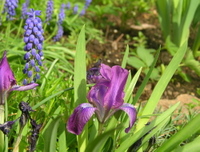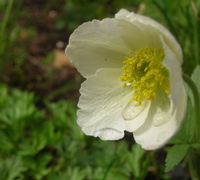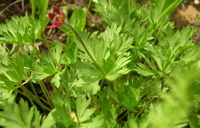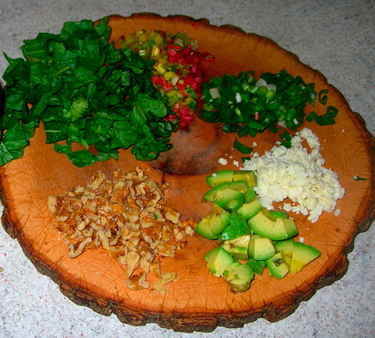All evidence to the contrary, I do have a garden.
 This is what we generally call the Circle, I’m not sure why. (Actuallly, it looks sort of square here, which is weird.)
This is what we generally call the Circle, I’m not sure why. (Actuallly, it looks sort of square here, which is weird.)
When we moved in seven years ago, there was a circular hole in the cement of our patio. Herbs, I thought, since the Circle is about two steps from the French doors to the dining-room/kitchen area. Yes, and some perennials for color. Restock with annuals every year? Forget it.
The first time I took a shovel to this dirt, I just about gave up the plan to plant anything at all. It was almost solid, knit together with a mat of finely meshed roots. I dug through it all, mixed in plenty of compost, and set out the first plants. Well and good.
That fall, I decided to add more compost, and being still under the impression that all amendments must be dug in, I got out the shovel, set it to the dirt, and found–the same thing I’d encountered that spring.
This went on for a couple of years. (I’m a slow learner.) Then, I noticed that although some things never did well in the Circle, others thrived.  I could put pansies from the same box, on the same day, into the Circle and into the border by the lawn, no more than five feet away, and the former would languish while the latter would grow to the size of small bushes.
I could put pansies from the same box, on the same day, into the Circle and into the border by the lawn, no more than five feet away, and the former would languish while the latter would grow to the size of small bushes.
My little spring bulbs, however–snowdrops, grape hyacinth, miniature iris–did just fine, and I never heard a peep out of the delphinium. Anemone flourished, as did the tiny red-flowered native cliff anemone.And the herbs–oregano, sage, thyme–kept us supplied all year long.
heard a peep out of the delphinium. Anemone flourished, as did the tiny red-flowered native cliff anemone.And the herbs–oregano, sage, thyme–kept us supplied all year long.
Clearly, it was time to throw in the trowel. So I did. Anything that wanted to live there, I decided, would have to make it on its own. It would get no help from me. Since then, the only digging I’ve done there has been to make holes for new plants.







 Subscribe to RSS feed
Subscribe to RSS feed


